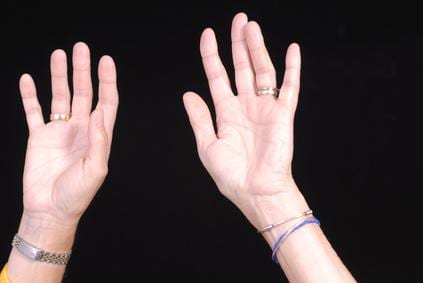Rheumatoid arthritis (RA) is of one of three types of arthritis. RA is an autoimmune disease that can happen to people at any age, although it is most common in people who are 40 to 60. It affects women more than it does men, according to the Health Guide from “The New York Times.”RA is most common in the wrists, fingers, feet, ankles and knees.
Symptoms
Autoimmune diseases are your body’s immune system mistakenly attacking your body’s tissues. RA affects your joints. When RA begins in your body, it usually starts in your hands or feet. You may have joint pain, joint swelling, joints that are tender when touched, red and puffy hands or firm bumps of tissue under your skin on your arms, according to MayoClinic.com. Doctors don’t know what causes RA, although it appears that genetics play a likely role. You probably won’t inherit RA, but you may have a predisposition to it, if it runs in your family.
Flare-Ups
Once you get RA, you will always have it, but it can go into remission. When you are feeling symptoms, you are having a flare-up or a flare. If you think you have RA and have symptoms, you should see your doctor for treatment methods.
Makes Using Your Hands Difficult
RA can be debilitating and disfiguring. When it affects your hands, at first it may be difficult to perform normal tasks. It could progress to the point that you are not able to do certain daily tasks that include using your hands. Treatments may stop more damage from occurring or may even be able to prevent damage from happening, according to MayoClinic.com.
Medication Options
Treatment options include medications, physical and occupational therapy and surgery. The medications that treat RA are strong and have potentially serious side effects. Your doctor will prescribe medications with the fewest side effects first, according to MayoClinic.com. You can get nonsteroidal anti-inflammatory drugs, also called NSAIDS, over-the-counter (OTC) or by prescription. OTC versions have ibuprofen or naproxen as the active ingredient. Prescription versions are stronger, but they could cause ringing in your ears, bruising, ulcers and liver or kidney damage.
Steroids, such as prednisone, reduce pain, swelling and slow joint damage. Side effects include bruising, thinning of bones, weight gain, cataracts and diabetes. Steroids usually treat acute symptoms, with the goal being to taper off. Other medications your doctor may prescribe include disease-modifying anti-rheumatic drugs, immunosuppressants and tumor necrosis factor-alpha inhibitors, all with varying degrees of treatment versus risks.
Therapy
An occupational therapist can help you learn methods to cope during a flare. For example, if your fingers hurt, you can learn to pick up an object using your forearms. Open a glass door by leaning into it rather than pushing it with your hands. You can also use special tools to help you grip and grab tools when you are working in the kitchen.
When you are not in pain, you can try doing some hand exercises to strengthen them. You can apply heat for 15 minutes if you are in pain. Cold numbs the pain, so use whichever one works best for you. Some people soak their hands in warm water for four minutes and then in cool water for one minute, repeating for 30 minutes, according to MayoClinic.com.
Surgery
If nothing is really helping, you might consider surgery with the goal of being able to use your hands again, reduce pain and correct any deformity. Options are total joint replacement, tendon repair, removal of the joint lining or joint fusion, all of which you can discuss with your doctor.
Photo Credit
- hands image by jimcox40 from Fotolia.com





